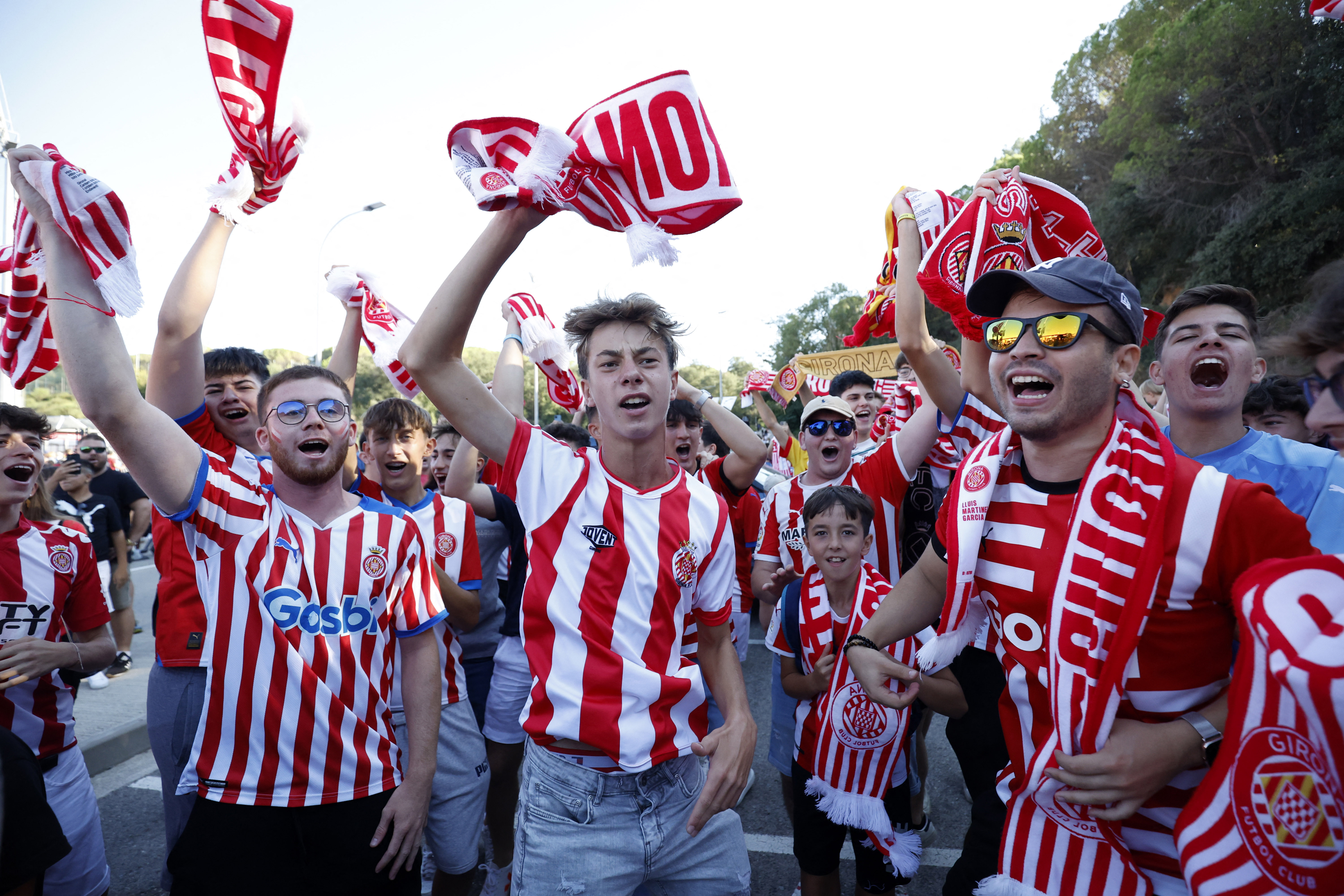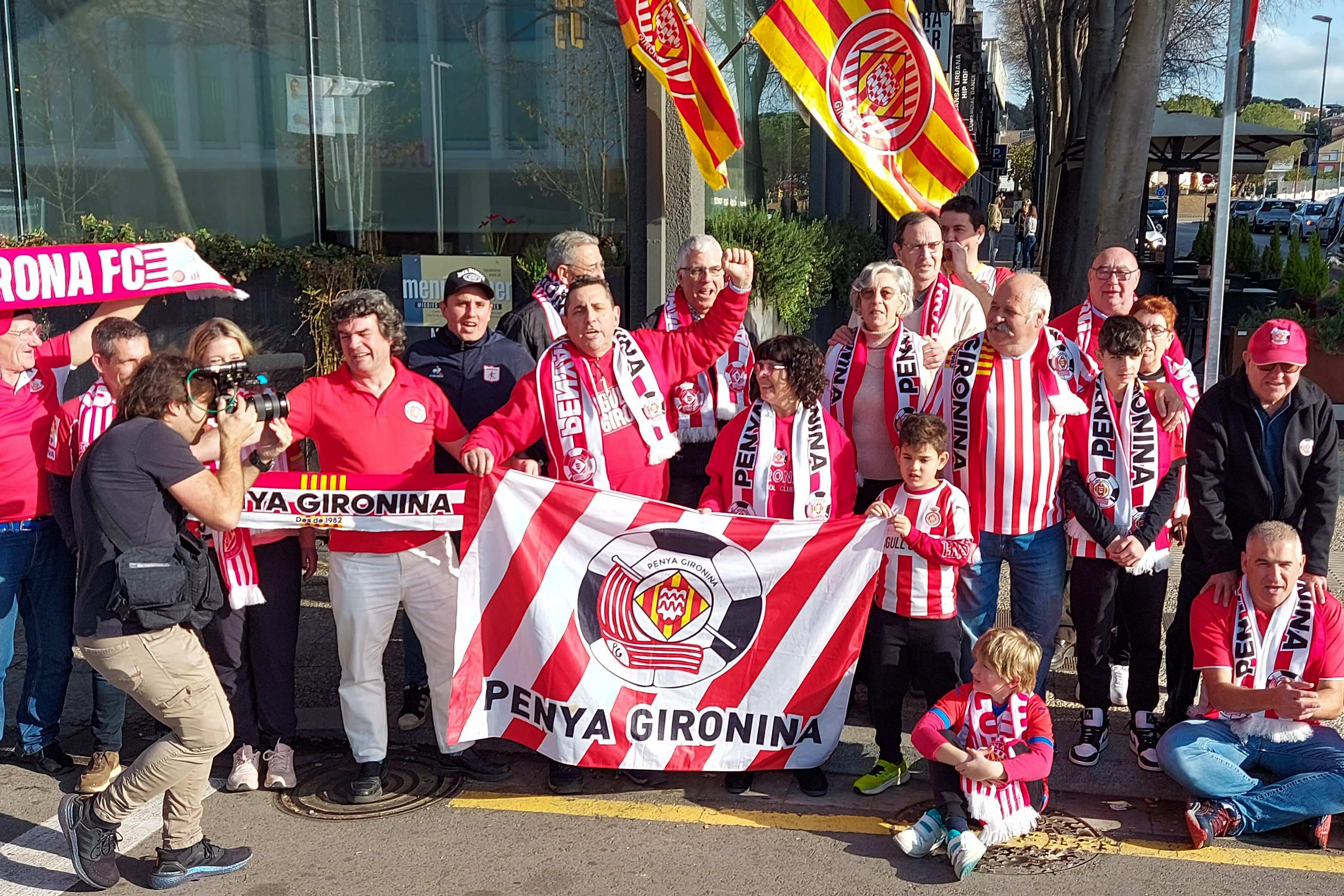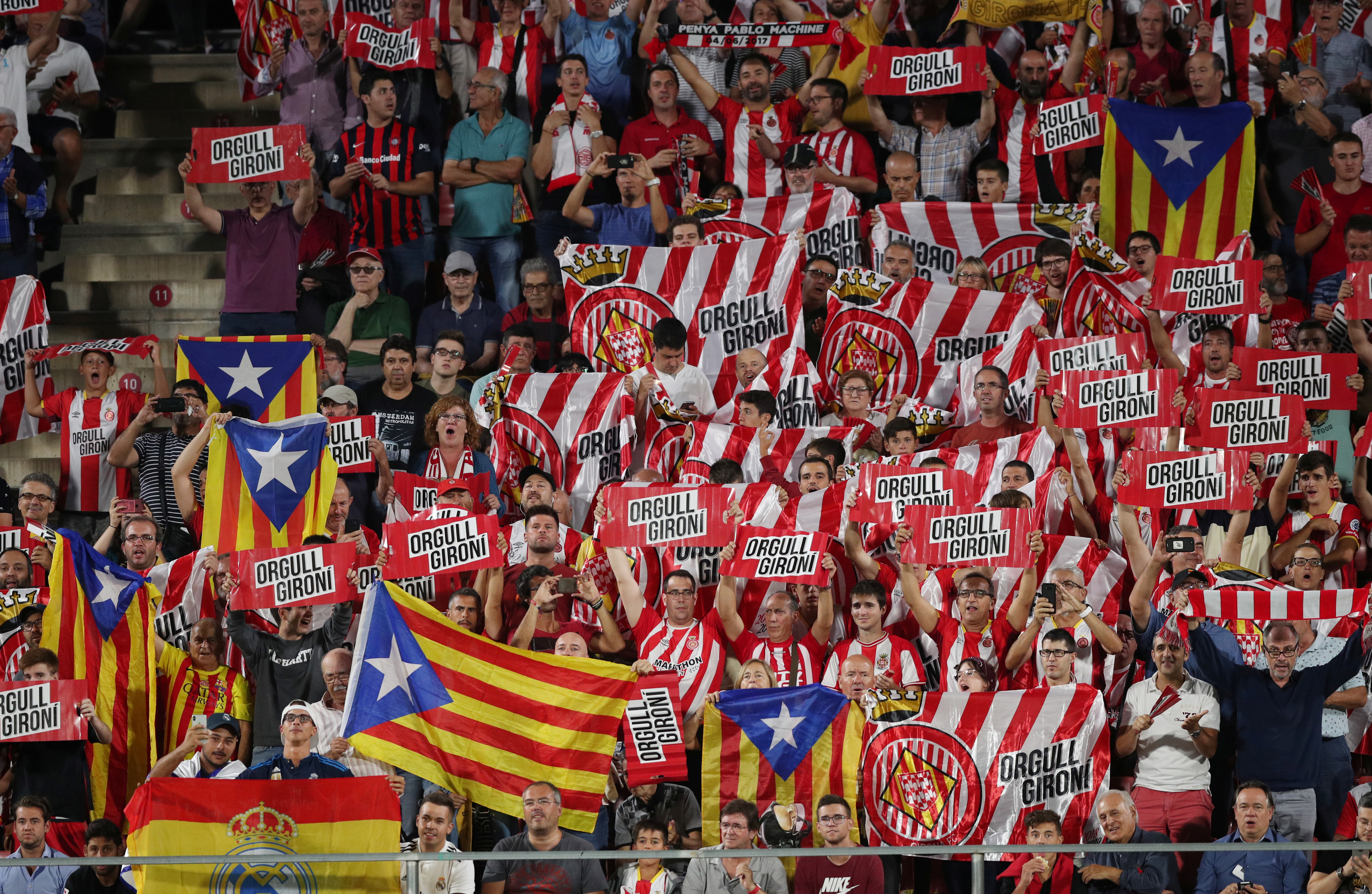
Girona, Spain – Decked out with Girona’s flags, signed shirts and banners, the Graner bar is home to the Penya Gironina, the club’s biggest fan club.
Wearing the team’s red-and-white shirts, a mix of greying heads, middle-aged women and young boys and girls gathered here to watch their team playing away to Celta Vigo in La Liga.
All relishing their improbable rise to the summit of Spanish football.
The Graner is in a drab suburb of this northeastern city, whose centre boasts beautiful medieval architecture which attracted 8.5 million tourists last year.
In the same suburb is Estadio Montilivi, the club’s pocket-sized stadium which fits only 14,000 fans, about a sixth of the size of neighbouring Barcelona’s Nou Camp home.
With their Catalan counterparts adrift in third place, Girona, with only one Costa Brava Cup to boast as silverware, are defying all odds to vie with Real Madrid – 35-time Spanish champions and 14-time Champions League winners – for the La Liga title.
Tickets, while the club languished for years in the lower leagues, were once difficult to give away. Now, every game sold out.
“The first thing to tell you is: Always watch Girona,” Graham Hunter, an expert on Spanish football, told Al Jazeera.
“They are a hell of a rollercoaster ride – always on the attack with apparently very little commitment to defending, with a thrilling and swashbuckling style in equal measure.
“In short: They’re fun. Really good fun.”

‘There are days you have to pinch yourself’
Girona’s club mascot is a fly – in reverence to the legend that stinging flies from the tomb of Saint Narcissus helped the city defeat Napoleon’s besieging army in 1809.
The city, with a population of only 100,000, is now set to be a pest not only to giants of Spanish football but to Europe as well, via highly probable Champions League qualification.
Girona, near the French border, was previously best known for a railway bridge designed by Gustave Eiffel in the 1870s before he turned his attention to a rather better-known tower in Paris.
Now, it is known for attracting skiing enthusiasts to the slopes on the Pyrenees in winter months or enthralling tourists during its Temps de Flors (time of flowers) festival in May – when houses, alleyways and streets are decked with blooms – and for its famous Costa Brava beaches in the summer months.
In economic terms, the city’s biggest export is chemical products. In sporting terms, its basketball team was its biggest success – until now.
Lluis Bosch, president of the Penya Gironina fan club, admits he can hardly believe what is happening this season.
“There are days you have to pinch yourself to believe it. It seems unreal,” he told Al Jazeera while watching Girona beat Celta Vigo 1-0.

The transformation
A quarter of a century ago, Girona were playing in Spain’s fifth tier, a regional league. They were in the fourth tier as recently as 16 years ago.
Fortunes changed in 2017, when the City Football Group (CFG), took a 44 percent stake in Girona FC.
Sheikh Mansour bin Zayed Al Nahyan, a member of the Abu Dhabi royal family and vice president of the UAE, holds an 81 percent share of CFG, which owns clubs from Manchester City to New York City, Yokohama Marinos and Melbourne City.
This may prove a major problem. Should Girona qualify for the Champions League, it is likely CFG will have to sell some of its stake because, under UEFA rules, two clubs controlled by the same entity cannot compete in the same competition.
Girona’s success though, is not simply the arrival of big money.
Its remaining ownership is made up of Bolivian businessman Marcelo Claure, who owns 35 percent, while Catalonian Pere Guardiola, younger brother of Manchester City manager Pep, owns a 16 percent stake.
Guardiola clearly shares his older brother’s vision when it comes to football even though the 47-year-old followed the business side of the game. His acumen is credited as a key role in signing Ukraine international Viktor Tsygankov, their best player.
The manager Miguel Angel Sanchez Munoz – known as Michel – was a playing hero at Rayo Vallecano, a lowly team from a tough part of Madrid. The 48-year-old moved to Girona, learnt Catalan and now coaches the team in the language which is an integral part of the culture.
Indeed, at this level, CFG’s influence can be seen in the club’s data-based strategy. In 2021, Girona were bottom of the second division but CFG sent Michel a direct message saying that, according to their data, he was doing the right thing.
“All their data told them that the football we were playing was good enough to get us promoted and that, under no circumstances, was I to compromise or change anything,” Michel would say.
Another factor is the clever signings of strays from other leagues.
Aleix Garcia, a 26-year-old Spanish midfielder never capped for Spain and never really made it at Manchester City. Nineteen-year-old Savio Moreira de Oliveira, yet to be capped by Brazil, played in the Dutch second division for Jong PSV last season. Goalkeeper Paulo Gazzaniga, 32, has played only one friendly game for Argentina.
Enrique “Quique” Carcel, the sporting director, has been at the club for 10 seasons. He has overseen five promotion playoffs, two promotions and the only four seasons Girona have spent in Spain’s top division.
Hunter credits Carcel with these signings: “He finds lots of players which other clubs did not think much of and mixes them into a stew of a club which works well together.”

What’s a club without its fans
Wearing a traditional red Catalan barretina, a floppy hat which resembles a Christmas bonnet, season ticket holder, Joan Prado, beamed as he spoke about his team.
“This year we have done something really special,” he told Al Jazeera.
Prado travels 60km (37 miles) from his home on the French border to see Girona play at home. The 66-year-old businessman also crisscrosses Spain to see the team play.
“We are now known up and down Spain but the ideal thing would be if we won La Liga or the Super Copa.”
Joan Vicens, a 63-year-old businessman, is happy that Girona’s recent success has boosted interest in the city and tourism but remains nostalgic about the faithful fans who are not around to celebrate something they committed so much to.
What we are living is a dream. But, I think of all the people who were in the Penya [fan club] over the years when Girona was nothing and who are not with us any more. It makes me feel a bit sad,” Vicens said.
Jordi Fortia first went to see Girona with his father Josep when he was a child. Now, the 42-year-old businessman takes his six-year-old son Jan to see the games.
Fortia makes special biscuits for the club which are offered to the first team and visiting players. It is typical of the club’s family feel.
The team shirt, meantime, is sponsored by a local pet food company Gosbi, rather than international airlines or other multinationals.
Fortia says he loves the way Girona is playing – and winning – but also shares a tinge of sadness given his father, who died recently from cancer, is not here to enjoy it.
“If only my father could have seen them now. He would not believe how things are,” Fortia said. “If my father was here today, it would be amazing.”
Back at Graner, as Girona seal the win against Celta Vigo, Bosch speaks with barely-contained excitement about the prospect of playing Champions League football.
“That will mean that we can travel to some of the historic stadiums in Europe like Anfield, home of Liverpool,” he said.
“I still cannot believe I’m saying this.”
Should Girona lift La Liga when the next Temps de Flors comes round in May, all of Spain will not believe what they are seeing.








